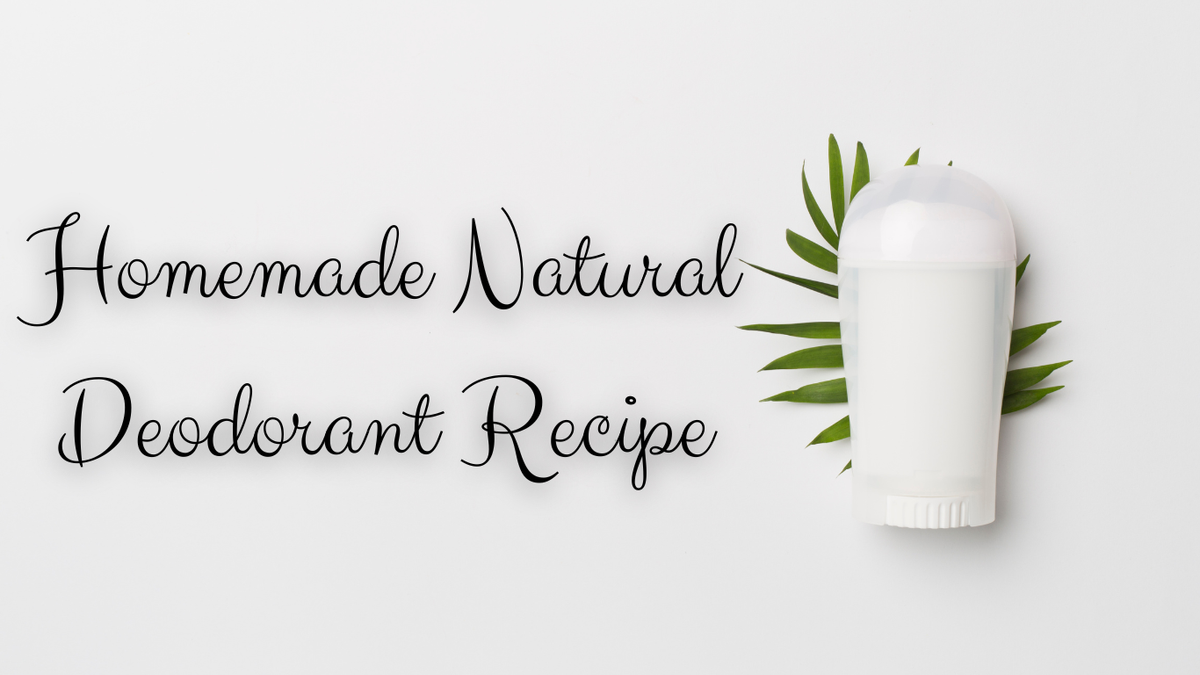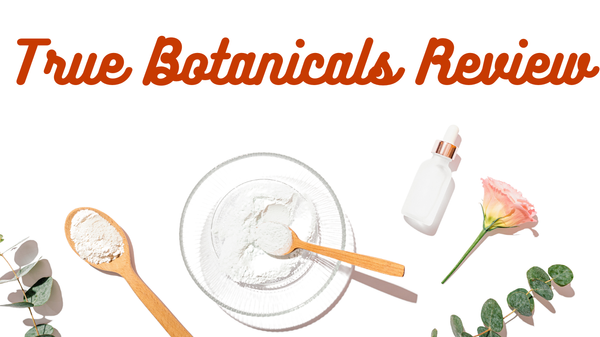Fresh and Pure: Homemade Natural Deodorant Recipe for a Healthy You
Discover the art of crafting a homemade natural deodorant with our detailed guide. Say goodbye to harmful ingredients and hello to freshness!

The Odor Dilemma: Embrace a Fresh Approach
Picture this: you're rushing through your morning routine, eager to conquer the day ahead. As you reach for your trusted commercial deodorant, have you ever stopped to wonder about the ingredients lurking within? Take a moment to consider the possible disadvantages of using products. These products often contain artificial fragrances and harsh chemicals.
Now is the moment to start embracing natural alternatives. Let's say goodbye to those deodorant sticks loaded with aluminum. Say hello to homemade natural deodorant!
The Benefits of Natural Deodorants: Nature's Gentle Touch
Choosing natural deodorants is an excellent decision for both your body and the environment. These concoctions are different from their commercial counterparts. They don't contain toxic chemicals like aluminum chlorohydrate or parabens. These chemicals may be harmful to health. They use plant-based ingredients. These ingredients work in harmony with your skin's delicate ecosystem.
Turning towards nature has a key advantage: it neutralizes odors. It does this without suppressing normal bodily functions, such as perspiration. Traditional antiperspirants clog sweat glands, blocking toxin release. This compromises our body's natural cooling system.
Homemade natural deodorants contrast with commercial ones. They allow sweat while stopping odor-causing bacteria.
Why Make Your Own Deodorant?
Empowerment in a JarMaking your own deodorant grants you an empowering sense of control over what goes onto your skin. Craft your own fragrant potions to perfectly match your preferences and values. Say goodbye to questionable additives or perplexing chemical compositions. Creating homemade deodorants can be immensely gratifying. It taps into our inherent desire for self-sufficiency and creativity. Moreover, it offers a sense of accomplishment. Imagine creating custom fragrances to match your mood or enhance your natural scent. Benefit from the calming effects of essential oils in the process. The process of customizing your deodorant is fulfilling and rewarding. It allows you to adjust it to your skin's needs and personal preference. Intrigued? In the following sections, we will discuss body odor. We will also examine harmful ingredients in commercial deodorants. Additionally, we will gather the ingredients and tools needed for homemade deodorant. Lastly, we will give step-by-step instructions for a basic recipe. So get ready to embark on a fragrant journey toward freshness and well-being!
The Science Behind Body Odor and How Deodorants Work
Unraveling the Mysteries of Body Odor
Ah, the fascinating world of body odor! Understanding the science behind aroma can explain deodorants as allies. You see, our bodies possess millions of sweat glands, and when they go into action, they produce sweat.
Now, this sweat is mostly made up of water and salt, which are naturally odorless. However, when it comes into contact with bacteria on our skin's surface, magic happens!
These bacteria feast upon the sweat and produce compounds that give off a distinct smell – voila! Body odor is born.
Enter Deodorants: The Superheroes Against Stinkiness
Thankfully for all of us who value fresh-smelling armpits (and those around us), deodorants swoop in to save the day. But how do they work their wondrous magic? Deodorants have antimicrobial agents. These agents act like superheroes against bacteria. Bacteria cause sweat to break down.
These agents inhibit bacterial growth or kill them altogether. By doing so, deodorants effectively reduce or eliminate body odor.
The Difference Between Deodorants and Antiperspirants
Now you might be wondering: what about antiperspirants? Aren't they just like deodorants?
Well, not quite! Both products combat sweat odors. Antiperspirants reduce perspiration further.
They contain aluminum salts that form temporary plugs in your sweat ducts and help minimize sweating. If you sweat a lot and want extra protection against wetness and odor, use antiperspirant.
The Role of Fragrance in Deodorants
Apart from fighting off those pesky bacteria, deodorants also often contain delightful fragrances. These fragrances have two purposes. The first purpose is to help hide any remaining smell. This smell can still be present despite using deodorant effectively.
Second, and perhaps more importantly, they leave you feeling fresh and confident throughout the day. Just imagine walking around smelling like a field of blooming flowers or a tropical paradise – it's an instant mood booster!
Understanding Harmful Ingredients in Commercial Deodorants
Deodorants aim to keep us fresh and confident, but be cautious. Some commercial products might have harmful ingredients. Common culprits include parabens, triclosan, phthalates, and synthetic fragrances.
These ingredients have caused worry. They may disrupt hormones and cause allergies. However, fear not!
The beauty of making your own homemade natural deodorant lies in knowing exactly what goes into it – no harmful chemicals included. So there you have it: the science behind body odor laid bare, along with how deodorants work their magic to combat unpleasant smells.
Armed with this knowledge, we can move on to the next step – gathering our ingredients and tools to craft our very own homemade natural deodorants! Before we continue, let's better understand harmful ingredients in deodorants. This will help us make healthier choices for our underarms.

Homemade Deodorant Spray Recipe
For a gentle, effective, and natural homemade deodorant spray, you'll need:
- 1/2 cup witch hazel
- 1/4 cup aloe vera gel (or juice)
- 1/4 teaspoon baking soda
- 10 drops of essential oil (lavender, tea tree, or peppermint work well)
Instructions:
- Mix the witch hazel, aloe vera, and baking soda together in a bowl.
- Add in your choice of essential oils.
- Stir the mixture until well combined.
- Pour the mixture into a spray bottle. Your homemade deodorant spray is now ready to use!
Apply this natural deodorant spray under your arms daily or as needed. Always shake well before use.
Gathering Ingredients and Tools
Essential Oils: Exploring Different Scents and Their Benefits
Making your own homemade natural deodorant is easy. Essential oils are the secret ingredient. They add delightful scents and provide additional benefits. There is an array of essential oils to choose from, each with its own unique aroma and properties.
Lavender oil, for example, not only has a calming scent but also possesses antibacterial properties that can help combat body odor. Tea tree oil is a great choice because it fights odor-causing bacteria and leaves a refreshing scent. It has antimicrobial properties.
Other popular options include lemon oil for a citrusy freshness or eucalyptus oil for a cool and invigorating aroma. Feel free to experiment with different essential oils until you find your perfect fragrance blend.
Base Ingredients: Arrowroot Powder, Baking Soda, Coconut Oil, etc.
There are a few key base ingredients for your homemade natural deodorant recipe. These ingredients provide effective odor control and moisture absorption. Arrowroot powder is a great alternative to talcum powder. It absorbs extra moisture and doesn't clog pores or irritate skin.
Baking soda plays a vital role in neutralizing odors. It creates an alkaline environment that inhibits bacteria growth. Coconut oil acts as the binding agent in the recipe while moisturizing the skin with its nourishing properties.
Optional Additives: Shea Butter, Beeswax, Activated Charcoal, etc.
Consider adding optional additives to elevate and improve your homemade deodorant recipe. Shea butter not only provides additional moisturization but also aids in soothing irritated skin thanks to its anti-inflammatory properties.
Beeswax can be added if you prefer a firmer consistency, providing a smooth and easy application. Activated charcoal is a great choice for those seeking extra detoxification. It helps to draw out impurities and absorb toxins from the skin.
Equipment Needed for Preparation
Before diving into the realm of making your own deodorant, it's essential to gather the necessary equipment to ensure a smooth process. The good news is that you don't need any fancy or specialized tools. Here's a list of what you'll need:
- Mixing bowl: A medium-sized bowl where you can combine all the ingredients thoroughly. - Whisk or spoon: To mix and blend the ingredients together until they form a smooth consistency.
Accurate measurements are vital for desired results. Ensure you have various sizes of measuring spoons accessible. - Containers: Choose small jars or containers with tight lids to store your homemade deodorant.
Consider using glass containers to avoid any potential chemical leaching from plastic. Now you understand essential oils, base ingredients, additives, and tools. You can start making your natural deodorant at home.
Remember to experiment with different combinations. This will help you find your signature scent. It will also ensure effective odor control and comfort all day. Let's move on to the next step - creating a simple homemade natural deodorant recipe!
Simple Homemade Natural Deodorant Recipe
Mixing the Dry Ingredients Together
Creating your own homemade natural deodorant is simpler than you might think. To begin, you'll need to gather and measure the dry ingredients. In a clean bowl, combine ½ cup of arrowroot powder and 2 tablespoons of baking soda.
Arrowroot powder absorbs moisture. Baking soda neutralizes odor-causing bacteria. Use a whisk or fork to blend these powders together thoroughly, ensuring there are no clumps.
Adding the Liquid Ingredients Gradually While Stirring
Now that your dry ingredients are well-mixed, it's time to incorporate the liquid components into the recipe. Take ¼ cup of melted coconut oil and gradually pour it into the bowl while stirring continuously. Coconut oil not only provides a smooth consistency but also possesses natural antimicrobial properties.
Stir until all of the coconut oil is evenly distributed throughout the mixture. For added benefits, you can also include optional additives at this stage.
You can mix in 1 tablespoon of shea butter if you want. Shea butter moisturizes your skin. Alternatively, you can add half a teaspoon of activated charcoal. Activated charcoal has detoxifying effects. Be sure to blend these additional ingredients thoroughly into the mixture until they are evenly distributed.
Achieving Desired Consistency and Texture
As you stir in the liquid ingredients, pay close attention to the consistency and texture of your homemade deodorant mixture. It should have a creamy yet firm texture that holds its shape when scooped out with your fingers or a small spatula.
If your mixture appears too dry or crumbly, gradually add more melted coconut oil in small increments until it reaches a smoother texture. If the mixture seems too wet or runny, sprinkle more arrowroot powder into it. Stir continuously until you reach the desired thickness.
Storing the Homemade Deodorant Properly
Achieving the desired texture is important for homemade deodorant. Store it properly to maintain effectiveness. Transfer the mixture into a clean, airtight container such as a small glass jar or a reusable deodorant tube.
Beforehand, ensure that the container is thoroughly cleaned and dried. This will prevent any unwanted bacterial growth. Store your homemade deodorant in a cool, dry place away from direct sunlight.
High temperatures can cause the coconut oil to melt and affect the overall consistency of your deodorant. If necessary, you can refrigerate it for a short period to help it solidify faster.
Remember to label and date your homemade deodorant container for easy reference. This natural creation can last 2 to 4 months with proper storage and regular use. The duration depends on personal usage habits.
Creating your own natural deodorant is healthier and reduces chemical exposure. Homemade deodorant supports better underarm care than commercial options. Follow these steps. Customize them to your preferences. You'll find an effective, eco-friendly alternative.
Customizing Your Deodorant Recipe
Exploring variations with different essential oils for scent preferences
When it comes to homemade natural deodorants, one of the most exciting aspects is the ability to customize the scent to your liking. Essential oils not only add a pleasant aroma but also offer additional benefits for your skin and overall well-being.
You have a wide array of options when it comes to choosing essential oils, each with its own unique fragrance profile. For a refreshing and invigorating scent, consider adding a few drops of peppermint or eucalyptus oil.
If you prefer something floral and calming, lavender or rose oil might be the way to go. Experiment with different combinations until you find the perfect scent that makes you feel confident all day long.
Adjusting ingredient ratios based on personal skin sensitivity or climate
One of the great advantages of making your own deodorant is having complete control over its formulation. You can customize your homemade deodorant by adjusting ingredient ratios. This allows it to meet your specific needs and preferences. Individuals with sensitive skin can avoid irritation by removing baking soda from the recipe.
Instead, increase the amount of arrowroot powder or cornstarch for moisture absorption. In hot and humid climates, sweat is more noticeable. To combat this, increasing the amount of coconut oil improves its ability to wick away sweat while still preventing odor.
Moreover, your personal preference is key in finding the perfect texture. This applies to your homemade deodorant. If you prefer a solid stick consistency that glides smoothly onto your skin, adding beeswax can help achieve that desired result.
If you prefer a softer texture, use less coconut oil. You can apply it easily with your fingers for a creamy feel. Another consideration when adjusting ingredient ratios is the amount of essential oil.
While it adds fragrance, it's important not to overdo it, as too much can potentially irritate the skin. Aim for a balanced ratio that provides a pleasant scent without overpowering.
Start with a few drops, and gradually increase until you achieve your desired level of aroma. Remember, creating your own deodorant recipe is all about experimentation and finding what works best for you.
Take note of any changes you make to ingredient ratios or scents so that you can replicate successful batches in the future. Get creative and have fun while making your own natural deodorant. Embrace your individuality and take care of yourself effectively. It should suit your needs perfectly.
Troubleshooting Common Issues
Addressing concerns like greasiness or irritation
Using homemade natural deodorant can be frustrating due to greasiness or irritation. However, there is no need to worry! There are simple solutions to tackle these pesky problems. If you find that your homemade deodorant feels too greasy on your skin, try adjusting the ratios of the ingredients.
Reduce the amount of coconut oil and increase the quantity of arrowroot powder or baking soda. This will help absorb excess moisture and reduce the greasy feeling.
On the other hand, if you experience irritation, it may be due to your skin's sensitivity to certain ingredients. One common culprit is baking soda, which can cause redness and itching for some individuals.
To address this issue, try using less baking soda in your recipe or look for alternative recipes that omit it altogether. Consider adding aloe vera gel or chamomile extract to soothe irritated skin.
Tips to prevent staining on clothing
One concern many people have when switching to homemade deodorant is the potential for stains on their clothes. However, with a few simple tips and tricks, you can keep your clothes looking fresh and stain-free. Firstly, allow your homemade deodorant to fully absorb into your skin before getting dressed.
Give it a couple of minutes to dry before putting on tight-fitting or light-colored clothing. This will minimize any transfer of oils onto fabric.
If you're concerned about stains, wear an undershirt for added protection. It creates a barrier between your skin and clothes, preventing staining. This acts as a barrier that helps prevent direct contact between the deodorant and fabric.
For stubborn stains that do occur over time, there are ways to tackle them effectively. Pre-treating stained areas with mild soap or a mixture of vinegar and water before laundering can help lift the stain.
Using natural laundry detergents for delicate fabrics is gentle and effective. Additionally, stain removers formulated for delicate fabrics are also gentle and effective. Remember, prevention is key!
To greatly reduce the chances of stains, follow these precautions and use fabric-friendly ingredients in your homemade deodorant recipe. Troubleshooting common issues with homemade natural deodorant is all about finding the right balance of ingredients for your skin and taking preventative measures to avoid staining.
With a bit of experimentation and patience, you'll soon find a deodorant recipe that suits your needs perfectly. Experience the advantages of chemical-free odor protection and keep your clothes fresh and clean.
Alternative Homemade Deodorant Recipes
Recipes for Sensitive Skin: If you have sensitive skin that tends to react to certain ingredients, fear not! Some homemade deodorant recipes use gentle ingredients like cornstarch or magnesium hydroxide. These alternatives can be effective and easy to make at home. Cornstarch is a fantastic option because it helps absorb moisture while being gentle on the skin.
To create a basic deodorant, mix 1/4 cup cornstarch, 1/4 cup coconut oil, and some drops of essential oil for scent. Mix all the ingredients thoroughly until well combined, and voila!
You have a soothing deodorant suitable for even the most sensitive skin.
Recipes for Heavy Perspiration
For those who tend to break a sweat more than others, fret not!
There are homemade deodorant recipes specifically designed to combat heavy perspiration. You can make a recipe by combining 1/4 cup of baking soda. Add 1/4 cup of arrowroot powder to the recipe. Then, mix in 1/4 cup of melted shea butter or cocoa butter for extra moisture control.
Baking soda and arrowroot powder absorb excess moisture. Shea or cocoa butter nourishes underarms, keeps them fresh all day. Feel confident even during intense workouts with this powerful homemade deodorant recipe!
Tips and Tricks For Homemade Deodorants
Making your own natural deodorant is great. However, some may experience irritation due to sensitivity to certain ingredients. This includes baking soda. If you find yourself facing this issue, simply reduce or eliminate the amount of baking soda in your recipe and replace it with more arrowroot powder or cornstarch.
Additionally, adding a small amount of a soothing ingredient like aloe vera gel or chamomile extract can help calm any skin irritation that may occur. Maximize Shelf Life: One common concern with homemade deodorants is their shelf life.
To ensure your deodorant stays fresh for as long as possible, store it in a cool, dry place away from direct sunlight. Consider adding natural preservatives like vitamin E oil. It has antioxidant properties and extends shelf life. Use it in your homemade deodorant.
Experimenting with Scents: One of the joys of making your own homemade deodorant is the ability to customize the scent to your liking. Try different essential oils like lavender, tea tree, or citrus blends to find the fragrance that suits you best.
Remember to start with just a few drops and gradually increase if needed. Essential oils add pleasant aroma. They combat odor-causing bacteria with antimicrobial properties.
Before fully committing to a new homemade deodorant recipe, it's always wise to perform a patch test. This test should be done on a small area of your skin. Don't forget about patch testing. This will help you identify any potential allergic reactions or sensitivities before applying it to larger areas.
Apply a small amount of the prepared deodorant on an inconspicuous area like your inner arm or behind your ear and wait for 24 hours. If there's no adverse reaction, you're good to go!
With these different recipes and helpful tips, you can confidently make your own natural deodorants. These deodorants will be customized to meet your needs. Enjoy the benefits of fresh and odor-free underarms all day long! Embrace the freedom of knowing exactly what goes into each product.
Additional Tips and Tricks
Storing homemade deodorants to maximize shelf life
To extend the shelf life of your homemade natural deodorant and keep it fresh, there are a few things to consider when storing it. Firstly, make sure you choose the right container.
Opt for a small glass jar or tin with an airtight lid. This will help prevent any contact with air and moisture that could degrade the ingredients over time.
Keep your deodorant away from direct sunlight and heat, as these factors can cause the oils in the recipe to melt or become rancid. A cool, dark place like a bathroom cabinet or drawer works best for storage.
If you live in a particularly warm climate, you might even consider keeping your deodorant in the fridge during hot summer months. It's crucial to prevent any contaminants when making homemade deodorant. This will ensure the quality is maintained.
Always use clean fingers or a spoon when scooping out the product to prevent bacterial growth. Additionally, try not to let water come into contact with the deodorant as it can lead to mold formation.
Natural deodorants may have shorter shelf lives than commercial counterparts. This is because they lack preservatives. Generally, it is recommended to use your homemade batch within 3-6 months. This ensures maximum freshness and effectiveness.
Key Takeaways
- Homemade natural deodorants are a safe and effective alternative to commercial options, free from harmful chemicals.
- The ingredients used in homemade deodorants, such as arrowroot powder, coconut oil, and essential oils, can be customized according to personal preferences and needs.
- Homemade deodorants are suitable for sensitive skin, provide heavy-duty protection, and align with an eco-friendly lifestyle.
- Proper storage of homemade deodorant in a cool, dry place and using clean utensils can extend its shelf life.
- Taking the natural route to personal care, such as creating your own deodorant, contributes positively to personal health and the environment.
- Experimenting and understanding the ingredients used in personal care products can foster confidence and pride in one's daily routine.
Thank you for your interest in The Wellness Ledger, where we share insights and tips on a healthier, eco-conscious lifestyle. Subscribe to our newsletter to stay updated on the latest trends, DIY projects, and helpful guidance to navigate your wellness journey. Embrace a life full of vitality and sustainability with us!




